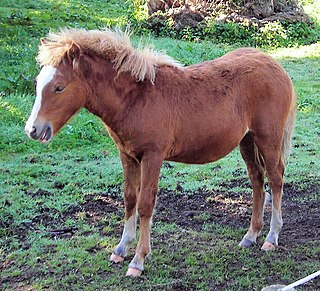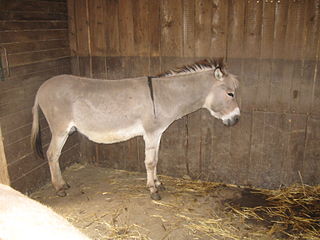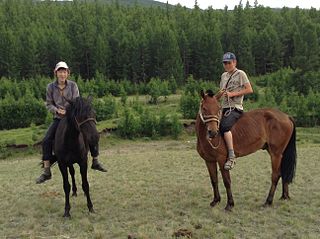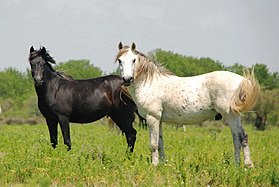
Kaimanawa horses are a population of feral horses in New Zealand that are descended from domestic horses released in the 19th and 20th centuries. They are known for their hardiness and quiet temperament. The New Zealand government strictly controls the population to protect the habitat in which they live, which includes several endangered species of plants. The varying heritage gives the breed a wide range of heights, body patterns and colours. They are usually well-muscled, sure-footed and tough.

The Eriskay Pony is a breed of pony from Scotland. It is generally grey in colour, and has a dense, waterproof coat that protects it in harsh weather. The breed developed in ancient times in the Hebrides of Scotland, and a small population remained pure and protected from crossbreeding by the remoteness of the islands. It is used for light draught work, as a mount for children, in many equestrian disciplines, and for driving.
The Peneia Pony is a rare breed of pony from the Peloponnese in southern Greece, originating in the former prefecture of Elis, which included the village of Peneia (Pineia).

The Pindos is breed of pony or small horse native to the Pindus mountain range in Thessaly and Epirus in Greece. It is also present in mountainous parts of Thrace and Macedonia. There is a feral herd near Neochori, Karditsa, close to Lake Plastiras.

A feral horse is a free-roaming horse of domesticated stock. As such, a feral horse is not a wild animal in the sense of an animal without domesticated ancestors. However, some populations of feral horses are managed as wildlife, and these horses often are popularly called "wild" horses. Feral horses are descended from domestic horses that strayed, escaped, or were deliberately released into the wild and remained to survive and reproduce there. Away from humans, over time, these animals' patterns of behavior revert to behavior more closely resembling that of wild horses. Some horses that live in a feral state but may be occasionally handled or managed by humans, particularly if privately owned, are referred to as "semi-feral".

The Lundy Pony is a British breed of pony bred on Lundy Island in the twentieth century.

The Kerry Bog Pony is a mountain and moorland breed of pony that originated in Ireland. Possibly descended from the Irish Hobby horse, it originally lived a mainly feral existence in the peat bogs of what is now County Kerry in southwestern Ireland. Local inhabitants used the ponies as pack and cart horses for transporting peat and kelp to the villages. The breed developed physical characteristics including a low weight-to-height ratio and an unusual footfall pattern, which helped it move on soft ground such as peat bogs. The ponies were known for hardiness and an ability to survive in harsh conditions.
The Banker horse is a breed of semi-feral or feral horse living on barrier islands in North Carolina's Outer Banks. It is small, hardy, and has a docile temperament, and is genetically related to the Carolina Marsh Tacky of South Carolina and Florida Cracker Horse breeds through their shared Colonial Spanish horse and Iberian horse descent. The current population of wild Banker horses is estimated to be about 400.

The Cyprus donkey is the donkey breed of the Mediterranean island of Cyprus. There are two principal strains: a large dark-coloured type with a pale belly, probably of European origin; and a small grey African type which represents about 20% of the total population, which in 2002 was estimated at 2200–2700.

The Catalan donkey is a breed of large domestic donkeys from the historic region of Catalonia, now in north-eastern Spain and south-western France. Approximately 80% of the breed population is in the modern autonomous community of Catalonia, and approximately 20% is in the historic Roussillon region of France.

The Balkan donkey or mountain donkey, Serbian: Domaći balkanski magarac, is a breed or group of breeds of domestic donkey originating in the Balkan region. It is reported from Serbia and Montenegro.

North American donkeys constitute approximately 0.1% of the worldwide donkey population. Donkeys were brought from Europe to the New World in the fifteenth century with the Second Voyage of Christopher Columbus, and subsequently spread into Mexico. They first reached what is now the United States in the late seventeenth century. Donkeys arrived in large numbers in the western United States during the gold rushes of the nineteenth century, as pack animals and for use in mines and ore-grinding mills. From about 1785, some large donkeys were imported from Europe to the eastern part of the continent.

The Lac La Croix Indian Pony (LLCIP), also known as the Ojibwe pony is a semi-feral Canadian horse breed developed by the Ojibwe people. The population became critically low; and, by 1977, only four mares remained. To preserve the breed, these mares were crossed with Spanish Mustang stallions. The modern breed name derives from the Lac La Croix First Nation of Ontario, where the horses were last found in the wild. Historically, the breed was also found in Minnesota.

The Thüringer Waldesel or Thuringian Forest Donkey is a recently created German breed of domestic donkey.

The Lavradeiro or Wild Horse of Roraima is a Brazilian breed or population of feral horses of Colonial Spanish type in the state of Roraima, in northern Brazil. The name derives from the lavrado or savannah terrain in that region.

The Kundudo horse is a population of wild horse native to Mount Kundudo in eastern Ethiopia. There are very few of them, but have been known to the local population for two centuries. They may have come from a small group of Abyssinian horses lost during military conflicts in the 16th century.

The Tuva is a breed of small saddle horses native to the Tuva region of Russia. Classified among the "Siberian pony" family, it proves to be much closer to the Mongolian horse, having lived relatively isolated from other Asian and Eastern European horses. It has long been ridden by the nomadic horse riders of its region, for breeding and hunting. At the end of the 19th century, mineral extraction led to the import of draft horses and saddles, giving rise through crossbreeding to the Upper Yenisei horse, now very rare, and the Tuva carriage horse, now extinct.

The Zakynthos is a breed of generally black saddle and combined driving horses originating from the island of Zante, one of the Ionian Islands, in Greece. The origin of this breed is very recent, dating back to the 20th century. This breed is of Anglo-Arabian type and is genetically close to the Andravida. Genetic analysis shows that it has been crossed with the Thoroughbred. The Zakynthos may also be descended from the Nivernais-type Percheron. Its type remains unstable, and the breed has no official standards or identification documents.

















